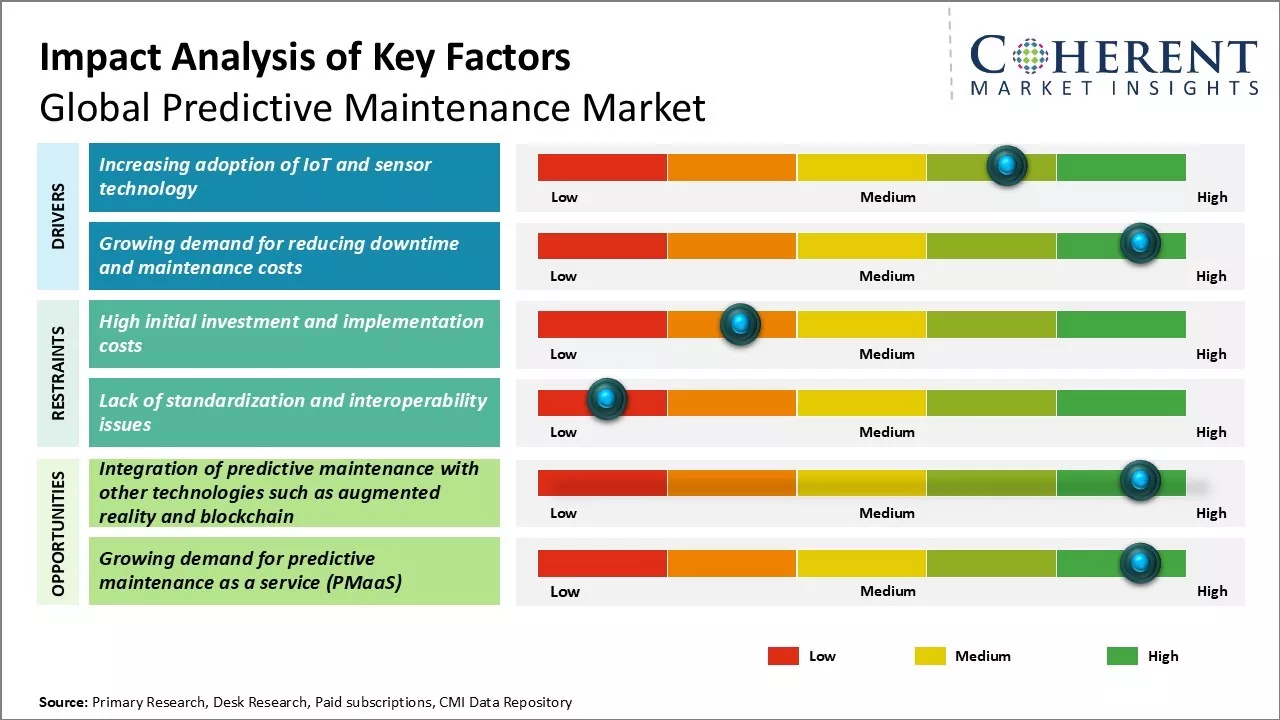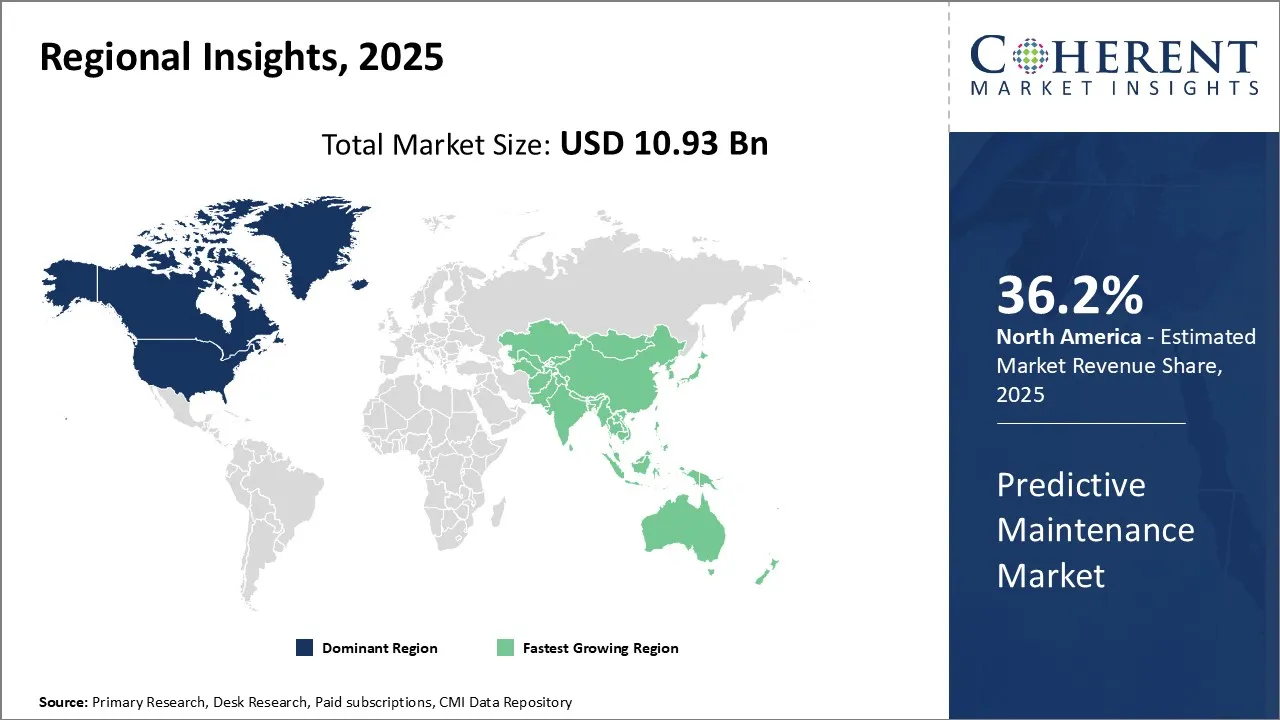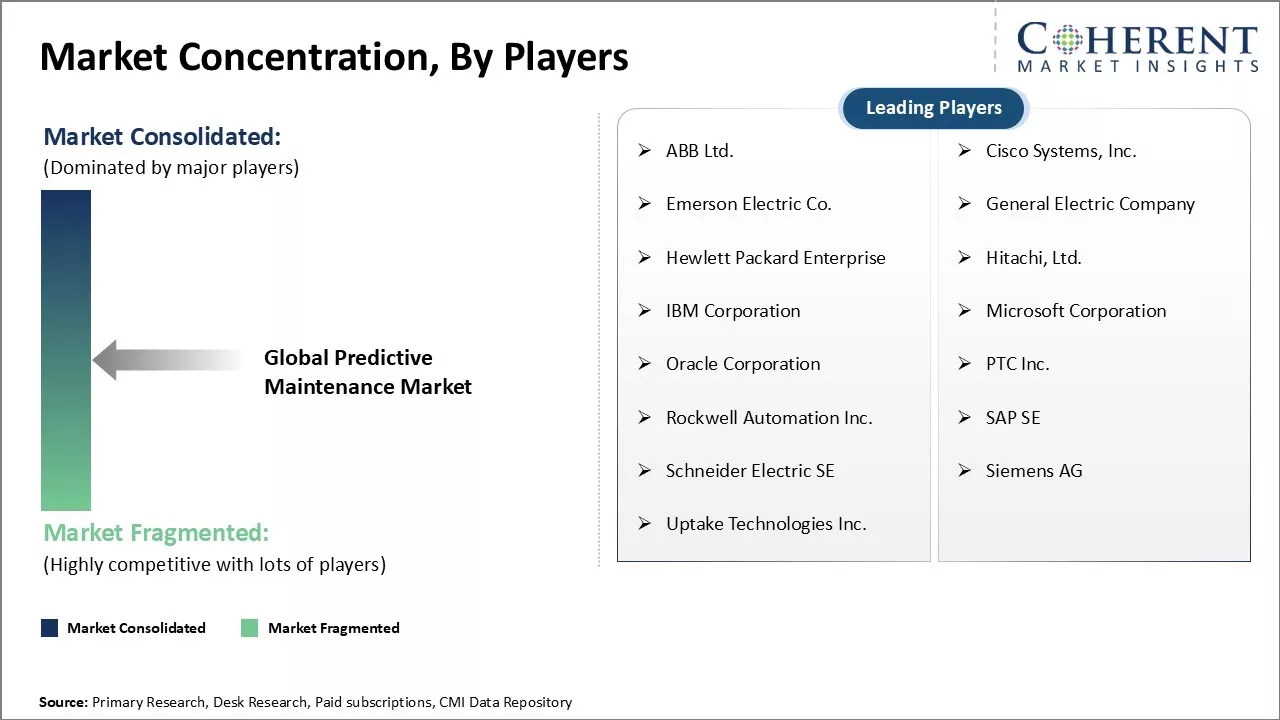The global predictive maintenance market is estimated to be valued at USD 10.93 Bn in 2025 and is expected to reach USD 44.00 Bn by 2032, exhibiting a compound annual growth rate (CAGR) of 22.0% from 2025 to 2032.

To learn more about this report, Download Free Sample
The predictive maintenance market growth can be attributed to factors such as rising adoption of IoT and automation technologies across industries. Predictive maintenance helps companies to optimize production planning and reduce unexpected downtime. It analyzes the condition of equipment in industrial units to predict faults and recommend scheduling of maintenance tasks. This helps companies improve operational efficiency and reduce maintenance costs. The growing need to cut capital expenses is also expected to drive greater adoption of predictive maintenance solutions in the coming years. With rise in complexities in industrial operations, predictive maintenance is anticipated to emerge as a vital tool for businesses to monitor assets health and performance continuously.
|
Current Event |
Description and its Impact |
|
Energy Transition and Infrastructure Modernization
|
|
|
Cybersecurity Threats and Industrial IoT Vulnerabilities |
|
Uncover macros and micros vetted on 75+ parameters: Get instant access to report
Artificial Intelligence (AI) plays a transformative role in the predictive maintenance market by enabling real-time monitoring, advanced analytics, and intelligent decision-making. AI algorithms analyze vast amounts of sensor data to detect patterns, forecast equipment failures, and recommend timely interventions—reducing unplanned downtime and maintenance costs. Machine learning models continuously improve accuracy by learning from historical performance and anomalies, while generative AI tools assist technicians with diagnostics and repair strategies. This shift from reactive to proactive maintenance enhances asset reliability, extends equipment life, and supports operational efficiency across industries such as manufacturing, energy, transportation, and aerospace.
For instance, in January 2025, Novelis adopted SymphonyAI’s Predictive Asset Intelligence platform to transition from preventive to AI-powered predictive maintenance across its 32 global plants. The solution enables real-time equipment monitoring, early fault detection, and reduced downtime. By integrating rule-based and machine learning alerts, Novelis enhances collaboration and operational efficiency, advancing its vision of the “plant of the future.”
In terms of component, solutions segment is expected to contribute 72.9% share of the market in 2025 owing to the elevated embracement of sophisticated predictive analytical solutions across industries. Monitoring emerging technological and malfunction patterns helps in optimizing asset performance and reducing maintenance costs. Various enterprises are increasingly shifting from conventional preventive to predictive maintenance using cutting-edge digital applications and services. This offers real-time equipment condition monitoring, automated failure detection, and prescriptive recommendations to avert downtime. Furthermore, the integration of innovative technologies like AI, IoT, and cloud computing within solution suites multiplies their scope and appeal. The openness to deploy on-prem and cloud platforms additionally raises the flexibility and scalability for businesses of all scales.
For instance, in January 2025, Megger launched its world-class predictive maintenance solutions across the UK and Ireland, aiming to revolutionize asset reliability and operational efficiency. These advanced tools offer real-time condition monitoring, early fault detection, and data-driven diagnostics, helping industries reduce downtime and optimize performance. The rollout reflects growing demand for intelligent maintenance technologies across critical infrastructure sectors.
In terms of technique, the vibration monitoring segment is expected to contribute 39.7% share of the market in 2025 owing to its non-intrusive fault diagnosis capabilities. As vibration signals carry unique signatures of mechanical and operational issues, the technique allows proactive equipment health tracking without disrupting regular processes. It detects anomalies by continuously measuring vibration levels and comparing real-time readings against historical benchmarks. This helps identify developing faults at nascent stages for swift intervention. Moreover, advancements like portable wireless sensors and condition-based parameter setting have augmented the application of vibration monitoring across industries and asset types.
For instance, in May 2025, Banner Engineering introduced the QM30VT3, a compact three-axis vibration and temperature sensor tailored for predictive maintenance. Designed for industrial environments, the sensor enables real-time monitoring of machine health, helping detect faults early and reduce downtime. Its advanced data capabilities support seamless integration into IoT systems, enhancing reliability and operational efficiency across sectors.
In terms of end-use industry, manufacturing is expected to contribute 32.2% share of the market in 2025 due to the massive need to optimize resource utilization. Unplanned downtime in production lines causes significant losses, forcing manufacturers to shift from routine-based to condition-based maintenance. Predictive solutions aid real-time performance oversight, spare parts deployment based on actual wear, and production planning as per demand fluctuations. This raises equipment effectiveness, throughput, quality control, and sustainability targets. Further, factories are increasingly leveraging predictive maintenance to achieve Industry 4.0 goals like predictive quality, dynamic scheduling, and remote problem-solving for enhanced output.
For instance, in June 2025, Alfa Laval unveiled Clariot™, its next-generation AI-powered condition monitoring solution for hygienic manufacturing. Designed to deliver 24/7 equipment diagnostics and real-time alerts, Clariot™ enables predictive maintenance for pumps and rotating machinery. The system helps manufacturers reduce downtime, optimize performance, and achieve Industry 4.0 goals through smarter, data-driven asset management.

To learn more about this report, Download Free Sample
North America has established itself as the dominant regional market for predictive maintenance globally. The region is expected to hold 36.2% of the market share in 2025. The region is home to some of the largest manufacturing and industrial companies who have aggressively adopted predictive maintenance solutions to optimize productivity and minimize downtimes. With many Fortune 500 companies based in the U.S. and Canada focusing on Industry 4.0 technologies, predictive analytics finds wide acceptance to drive efficient maintenance practices. Further, the presence of major predictive maintenance vendors in the region has ensured easy access to cutting-edge solutions and expertise.
For instance, in April 2025, MaintainX received Frost & Sullivan’s 2025 North American Technology Innovation Leadership Award for its AI-powered maintenance and asset optimization platform. The solution enables predictive maintenance through real-time equipment monitoring, intelligent diagnostics, and streamlined workflows. This recognition highlights MaintainX’s role in transforming industrial operations with data-driven strategies that reduce downtime and boost performance.
Asia Pacific has emerged as the fastest growing regional market for predictive maintenance. Several factors are contributing to the rapid growth, key among them being the massive industrialization and infrastructure development programs underway in countries like China, India, Indonesia, and Vietnam. The Make in India and Made in China 2025 initiatives lay strong emphasis on the digital transformation of manufacturing processes using technologies like IoT, AI, and predictive analytics. The growth in the number of industrial units has spurred the demand for predictive maintenance solutions from sectors like automotive, electronics, energy, and chemicals. At the same time, availability of low-cost skilled resources is enabling Asian companies to develop cost-competitive predictive maintenance offerings.
For instance, in October 2025, Schaeffler launched its Asia Pacific Remote Monitoring Center to deliver expert predictive maintenance services across the region. Supporting over 8,000 sensors for 77 customers, the center uses AI and machine learning to detect faults early, reduce downtime, and optimize asset performance. Staffed by certified vibration analysts, it marks a major step in industrial reliability.
The U.S. predictive maintenance market is booming due to aging infrastructure, rising operational costs, and the push for efficiency across industries. Companies are adopting AI-driven solutions to monitor equipment health, prevent failures, and reduce downtime. Integration with digital twins and IoT further enhances real-time diagnostics, making predictive maintenance vital for manufacturing, energy, and transportation sectors.
For instance, in November 2024, VoyageX AI launched a free three-month trial of its advanced Ship Maintenance Software for the North American maritime industry. Powered by AI, the platform enables predictive maintenance through real-time equipment monitoring, fault forecasting, and compliance tracking. The solution aims to reduce operational costs, minimize downtime, and enhance fleet performance with intelligent diagnostics and scheduling.
Japan’s predictive maintenance market is surging due to its advanced manufacturing sector, aging infrastructure, and push for Industry 4.0 integration. The adoption of AI, IoT, and robotics enables real-time equipment monitoring and fault prediction, helping reduce downtime and optimize operations. These technologies support Japan’s goal of maintaining global competitiveness and operational efficiency.
For instance, in October 2025, TDK's press release highlights its participation at CEATEC 2025, where it showcased several AI-driven innovations, including the edge RX solution, a predictive maintenance system for industrial machines. This solution uses sensors to collect and analyze vibration and temperature data in real time, enabling early anomaly detection and improved operational efficiency through cloud integration.
| Report Coverage | Details | ||
|---|---|---|---|
| Base Year: | 2024 | Market Size in 2025: | USD 10.93 Bn |
| Historical Data for: | 2020 To 2024 | Forecast Period: | 2025 To 2032 |
| Forecast Period 2025 to 2032 CAGR: | 22.0% | 2032 Value Projection: | USD 44.00 Bn |
| Geographies covered: |
|
||
| Segments covered: |
|
||
| Companies covered: |
ABB Ltd., Cisco Systems, Inc., Emerson Electric Co., General Electric Company, Hewlett Packard Enterprise, Hitachi, Ltd., IBM Corporation, Microsoft Corporation, Oracle Corporation, PTC Inc., Rockwell Automation Inc., SAP SE, Schneider Electric SE, Siemens AG, and Uptake Technologies Inc. |
||
| Growth Drivers: |
|
||
| Restraints & Challenges: |
|
||
Uncover macros and micros vetted on 75+ parameters: Get instant access to report
The rapid advancement of Internet of Things (IoT) technologies and proliferation of sensors have enabled industries to collect and analyze data from their assets and machines in real-time. IoT offers the ability to monitor individual parts and performance of critical systems continuously. This real-time monitoring generates vast amounts of useful condition monitoring data which can help predict failures or downtimes before they actually occur. With IoT, variables like vibration, temperature, pressure, and noise can be tracked remotely and alerts can be triggered when anomalous behaviors are detected. This helps maintenance teams to address issues proactively rather than waiting for failures to happen. Many industries that rely heavily on plant uptime such as manufacturing, transportation, energy, and utilities are actively deploying IoT sensors into their operations. As sensor technology becomes cheaper and more robust, more equipment and machinery across industries can be outfitted with smart sensors. This will drive greater predictive capabilities as maintenance teams are empowered with continuous health monitoring data. The widespread use of industrial IoT is set to profoundly change maintenance operations from reactive to proactive in the coming years.

To learn more about this report, Download Free Sample
Industries are under intense pressure to maximize equipment uptime while keeping maintenance costs low. Unplanned downtimes result in lost production time and can significantly hurt business productivity and profitability. At the same time, costs associated with maintenance and repair works need to be optimized. This is prompting many organizations to adopt predictive maintenance strategies to move from time-based and break-fix maintenance to condition-based maintenance. Predictive maintenance uses data analytics tools to monitor equipment health and detect early signs of wear and tear. This helps predict failures in advance and schedule maintenance work during planned downtimes rather than emergency breakdowns. It allows critical assets to run for longer without disrupting operations. With such substantial advantages, the demand for predictive maintenance solutions from industries is growing steadily to maximize asset performance and lower long-term maintenance expenditure. This growing demand opens up significant market opportunities for predictive maintenance vendors and technology providers.
The integration of predictive maintenance solutions with complementary technologies provides a major growth opportunity. Combining predictive maintenance with augmented reality enhances remote diagnosis and repair capabilities. Workers can access holograms and visual inspection aids using smart glasses. Similarly, deploying predictive maintenance on Blockchain networks offers the benefits of decentralization, transparency, and security of maintenance records. This allows asset owners to monitor equipment health from any location. By leveraging technologies like AI, IoT, cloud computing, and digital twins, predictive systems can glean richer insights from diverse data sources. Such integrations empower predictive maintenance with functionalities like autonomous condition monitoring and self-directed repairs. This drives higher equipment uptime and process efficiency. Global leaders are well-positioned to capitalize on this opportunity through strategic partnerships that deliver integrated digital solutions.
The global predictive maintenance (PdM) market has matured into a discipline where success depends less on algorithms and more on data quality, integration, and operational execution. When implemented effectively, PdM reduces unplanned downtime by 30–50% and extends asset life by up to 40%, as demonstrated in industrial deployments by Siemens and IBM. However, many pilots fail to scale because predictive insights are not embedded into maintenance workflows or inventory systems.
The economic rationale remains compelling: unplanned downtime can cost manufacturers over US$100,000 per hour, making predictive analytics a direct lever for risk reduction. Edge computing now plays a critical role by enabling real-time analysis closer to machines, while AI-driven models increasingly blend sensor data with physics-based insights. Yet, technology alone is insufficient, organizations must redesign processes, train cross-functional teams, and align incentives with reliability outcomes.
Industry consolidation is favoring vendors offering integrated hardware and software ecosystems, while specialist analytics firms succeed through partnerships. Beyond cost savings, PdM supports sustainability by extending equipment life and reducing waste. The verdict is clear: predictive maintenance is transformative only when embedded into daily operations. Firms that combine analytics with disciplined execution will achieve measurable reliability gains; others will see limited returns despite technological investments.
Share
Share
About Author
Ankur Rai is a Research Consultant with over 5 years of experience in handling consulting and syndicated reports across diverse sectors. He manages consulting and market research projects centered on go-to-market strategy, opportunity analysis, competitive landscape, and market size estimation and forecasting. He also advises clients on identifying and targeting absolute opportunities to penetrate untapped markets.
Missing comfort of reading report in your local language? Find your preferred language :
Transform your Strategy with Exclusive Trending Reports :
Frequently Asked Questions
Joining thousands of companies around the world committed to making the Excellent Business Solutions.
View All Our Clients